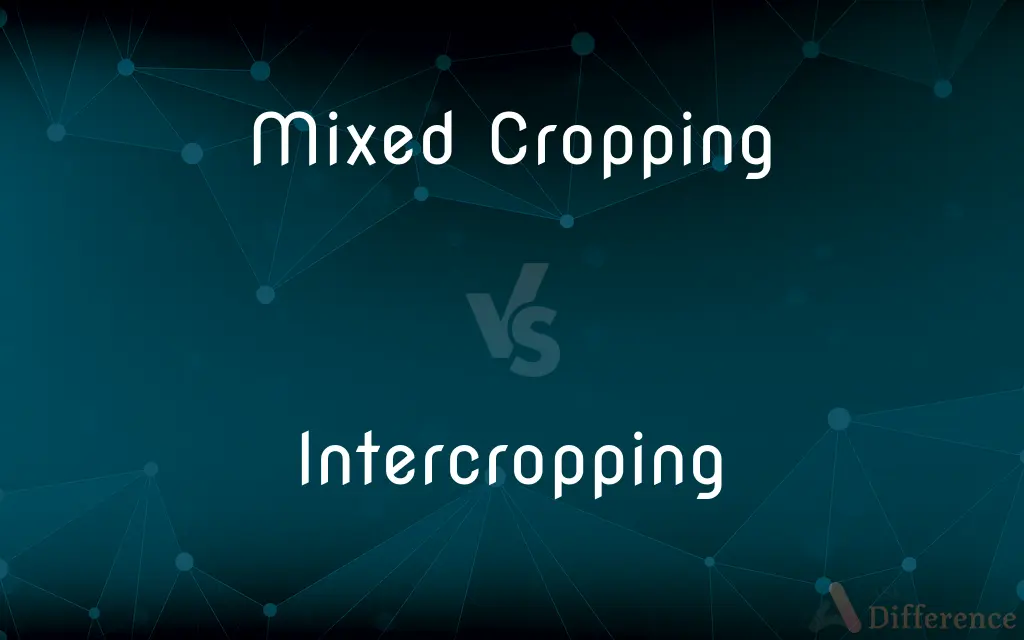Mixed Cropping vs. Intercropping — What's the Difference?
By Tayyaba Rehman — Published on October 31, 2023
Mixed Cropping involves growing two or more crops simultaneously in the same field, while Intercropping is the practice of growing two crops together in a specific pattern or arrangement.

Difference Between Mixed Cropping and Intercropping
Table of Contents
ADVERTISEMENT
Key Differences
Agriculture is abundant with diverse techniques, two of which are Mixed Cropping and Intercropping. Mixed Cropping refers to the cultivation of two or more crops simultaneously on the same field without any specific pattern. The primary goal of Mixed Cropping is to minimize the risk of total crop failure due to adverse weather conditions or pests. In this system, if one crop fails, the farmer still has the yield of the other crop(s) to rely on.
Intercropping, on the other hand, involves growing two or more crops together in a deliberate pattern or arrangement. The key distinction here is the systematic approach of Intercropping where crops are organized in rows or other specific configurations. This technique often results in better use of resources like sunlight, water, and nutrients as crops are chosen based on their complementary needs or growth patterns.
Both Mixed Cropping and Intercropping aim to maximize land utilization, increase biodiversity, and optimize yield. While Mixed Cropping operates more on chance, hoping that at least one crop will succeed, Intercropping employs strategic planning to ensure that the crops support one another. The mutual benefits could be in the form of pest control, resource use, or growth rate enhancement.
However, it's worth noting that neither method is superior universally. The choice between Mixed Cropping and Intercropping depends on factors like the local climate, soil type, available resources, and the specific goals of the farmer. While both methods promote biodiversity and can lead to increased resilience against pests and diseases, their implementation and management can differ significantly.
Comparison Chart
Definition
Growing multiple crops together without a pattern
Growing multiple crops in a specific pattern or sequence
ADVERTISEMENT
Purpose
Risk distribution and land optimization
Optimal utilization of resources and mutual crop benefit
Arrangement
Random
Systematic
Resource Sharing
By chance
Strategically planned
Example
Wheat and chickpeas grown together
Maize planted in rows with beans grown between them
Compare with Definitions
Mixed Cropping
Cultivation of multiple crops together without specific arrangement.
Farmers practiced Mixed Cropping by planting barley and mustard together.
Intercropping
Systematic co-cultivation for optimal resource utilization.
Farmers practiced Intercropping to ensure soil nutrients were efficiently used by both spinach and radishes.
Mixed Cropping
A method to reduce risk of crop failure.
Mixed Cropping ensured that if the potato crop failed, the carrots would still provide some yield.
Intercropping
Structured co-cultivation enhancing land productivity.
Using Intercropping, the farm achieved higher yields per acre.
Mixed Cropping
An approach to maximize land use without systematic planting.
Through Mixed Cropping, the land was covered with a mix of lentils and millets.
Intercropping
Agriculture technique for maximizing growth potential and compatibility.
The Intercropping of onions and lettuce resulted in better growth for both crops due to their complementary needs.
Mixed Cropping
A traditional farming method to enhance soil fertility and reduce pest attacks.
With Mixed Cropping, the peas added nitrogen to the soil benefiting the adjacent wheat crop.
Intercropping
Growing multiple crops in a specific pattern for mutual benefit.
Intercropping of beans between corn rows maximized sunlight usage.
Mixed Cropping
Diverse crop cultivation in a single field.
Mixed Cropping allowed the farmer to harvest both corn and sunflowers from the same plot.
Intercropping
A strategic method to boost yield and reduce pest attacks.
Intercropping tomatoes with basil helped repel certain insects.
Intercropping
To grow more than one crop in the same field, especially in alternating rows or sections.
Intercropping
To plant (a crop) in the same field with another.
Intercropping
Infl of intercrop
Common Curiosities
How does Intercropping differ from Mixed Cropping?
Intercropping involves growing multiple crops in a specific pattern or arrangement.
What is Mixed Cropping?
Mixed Cropping is growing multiple crops together in the same field without a specific pattern.
Why do farmers use Mixed Cropping?
Mixed Cropping helps reduce the risk of total crop failure and optimizes land use.
Do Intercropping systems require more planning?
Yes, Intercropping involves strategic planning to ensure crops complement each other.
Can Intercropping help in pest control?
Yes, Intercropping can deter pests when crops that repel certain pests are grown together.
Can both methods coexist on the same farm?
Yes, a farmer can use both Mixed Cropping and Intercropping in different fields or seasons.
What is the main advantage of Intercropping?
Intercropping allows optimal utilization of resources and provides mutual benefits to the crops.
Is Mixed Cropping random?
Yes, in Mixed Cropping, crops are grown together without a deliberate pattern.
Which method promotes biodiversity?
Both Mixed Cropping and Intercropping promote biodiversity.
How does Mixed Cropping benefit soil health?
Mixed Cropping can enhance soil fertility by growing crops that replenish different nutrients.
How do both methods affect crop yield?
Both methods, when executed well, can increase yield by optimizing land use and resources.
Is there a universal best choice between Mixed Cropping and Intercropping?
No, the choice depends on local conditions, available resources, and the farmer's goals.
How does Intercropping utilize sunlight efficiently?
In Intercropping, crops with varying heights and sunlight needs are grown together, maximizing sunlight use.
Which method is more labor-intensive?
Intercropping often requires more labor due to its systematic arrangement and management.
Is Mixed Cropping suitable for all crop combinations?
No, some crops might compete for the same resources, making certain combinations less effective.
Share Your Discovery

Previous Comparison
New York vs. Newark
Next Comparison
Bleu Cheese vs. GorgonzolaAuthor Spotlight
Written by
Tayyaba RehmanTayyaba Rehman is a distinguished writer, currently serving as a primary contributor to askdifference.com. As a researcher in semantics and etymology, Tayyaba's passion for the complexity of languages and their distinctions has found a perfect home on the platform. Tayyaba delves into the intricacies of language, distinguishing between commonly confused words and phrases, thereby providing clarity for readers worldwide.
















































